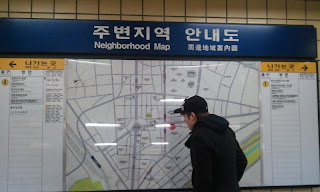 |
| The view just outside of my apartment building --cherry blossoms in bloom! |
Right on time, spring has sprung in Gwacheon and it feels quite lovely to
move into a new season. I’ve experienced
the humid heat of Korea’s summer, the chill of fall and the frosty feeling of
winter, so I am delighted to be entering into sweet-smelling spring. The sunshine’s bright, the air is fresh, and
the Cherry Blossoms are in full bloom. Here
we had such a wonderfully mild week with a refreshing (and persistent) downpour
this weekend –so what better time to sit down and write about it.
For this post, I thought that
using a poem from one of my favourite writers, Robert Frost, would help to convey my thoughts...
A Prayer in Spring
OH, give us pleasure in
the flowers today;
And give us not to think so far away
As the uncertain harvest; keep us here
All simply in the springing of the year.
Oh, give us pleasure in the orchard white,
Like nothing else by day, like ghosts by night;
And make us happy in the happy bees,
The swarm dilating round the perfect trees.
And make us happy in the darting bird
That suddenly above the bees is heard,
The meteor that thrusts in with needle bill,
And off a blossom in mid air stands still.
For this is love and nothing else is love,
To which it is reserved for God above
To sanctify to what far ends he will,
But which it only needs that we fulfill.
And give us not to think so far away
As the uncertain harvest; keep us here
All simply in the springing of the year.
Oh, give us pleasure in the orchard white,
Like nothing else by day, like ghosts by night;
And make us happy in the happy bees,
The swarm dilating round the perfect trees.
And make us happy in the darting bird
That suddenly above the bees is heard,
The meteor that thrusts in with needle bill,
And off a blossom in mid air stands still.
For this is love and nothing else is love,
To which it is reserved for God above
To sanctify to what far ends he will,
But which it only needs that we fulfill.
~Robert Frost
 |
| I took this photo on my way to the subway. Blue skies, fragrant blossoms... what's not to love? |
The English
major in me wants to annotate each part of the poem –couplet by couplet –to
explain how this poem relates to my current state; however, I will just a highlight
a couple of passages to avoid boring any readers.
In
university, it would have been pointed out how the prayer to “give us pleasure
in the flowers today;/ And give us not to think so far away/As the uncertain
harvest; keep us here” could be analyzed using Frye’s literary criticism –in
particular, the archetype of the four seasons. The professor would talk about how spring signifies the light-hearted genre of comedy, but points to darker things
like a certain tragic outcome in the fall or winter. A conversation
would have revolved around Frost’s use of the cyclical seasons to convey the
same tumultuous nature of life; spring is new life, winter is certain death. I would
have put square brackets around the stanza, wrote a note like “archetype of seasons” beside it, and followed
it up with a squiggly underline.
Now, as I read this poem, I see how the image of spring –with its joy and possibilities –can be used as a wonderful distraction from future worries of prosperity. As I inch towards the last third of my contract, I have received a lot of questions about my next step. Will I re-sign? Will I come home and look for a job? Will I look elsewhere and continue my travels? While my over-active mind tries to race ahead of itself, I will try to embrace Frost’s “prayer” to remain present in spring; especially with the “orchard white” of cherry blossoms and the “darting birds” (or curve balls), “for this is love” and what is better than being twitter-painted with life?
 |
| A row of cherry blossom-ing trees along one of the main streets in Gayang. Trés beau! |






